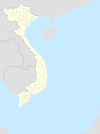Flag of Vietnam
 | |
| Name | Cờ đỏ sao vàng ("red flag with a golden star") Cờ Tổ quốc ("flag of Fatherland") |
|---|---|
| Use | Civil and state flag |
| Proportion | 2:3 |
| Adopted | November 23, 1940 1955 (current version) |
| Design | A large yellow star centered on a red field. |
| Designed by | Nguyễn Hữu Tiến |
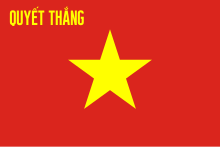 Variant flag of Vietnam | |
| Name | Flag of the People's Army of Vietnam |
| Use | War flag |
| Proportion | 2:3 |
| Design | A golden star centered on a red field, and yellow words Quyết thắng (determined to win) in the upper canton. |
| Designed by | Design is a variant of the flag of Vietnam |
 Variant flag of Vietnam | |
| Name | Flag of the Vietnam People's Public Security |
| Use | Police flag |
| Proportion | 2:3 |
| Design | A golden star centered on a red field, and yellow motto Bảo vệ an ninh tổ quốc (Protecting the Fatherland's Security) in the upper canton. |
| Designed by | Design is a variant of the flag of Vietnam |
 Variant flag of Vietnam | |
| Name | Ensign of the Vietnam People's Navy |
| Use | Naval ensign |
| Proportion | 2:3 |
| Adopted | 15 January 2014 |
| Design | A white flag with an emblem of the Vietnam People's Navy in the top and a blue strip below. |
| Designed by | People's Army of Vietnam |
The flag of the Socialist Republic of Vietnam, or Cờ đỏ sao vàng (red flag with a golden star[a]), also Cờ Tổ quốc (flag of Fatherland), was designed in 1940 and used during an uprising against the French in southern Vietnam that year.[1] The red background symbolizes bloodshed, revolution and struggle. The yellow star represents the five main classes in Vietnamese society — workers, farmers, soldiers, intellectuals, and entrepreneurs.[2]
The flag was used by the Viet Minh, a communist-led organization created in 1941 to oppose Japanese occupation. At the end of World War II, Viet Minh leader Ho Chi Minh proclaimed Vietnam independent and signed a decree on 5 September 1945 adopting the flag as the flag of the North Vietnam.[3] The DRV became the government of North Vietnam in 1954 following the Geneva Accords. The flag was modified on 30 November 1955 to make the rays of the star pointier.[4] Until the end of the Vietnam War in 1975, South Vietnam used a yellow flag with three red stripes. The red flag of North Vietnam was later adopted as the flag of the unified Vietnam in 1976.[5] The flag of Vietnam is the only flag amongst South East Asian nations that does not contain the colour white, with red and yellow/gold being its historical national colours.[6]
Design and history[]
Vietnamese flag colours have often been various designs of red and bright yellow. According to the 1992 constitution: "The National Flag of the Socialist Republic of Vietnam is rectangular in shape, its width is equal to two thirds of its length, in the middle of fresh red background is a bright five-pointed golden star".[7]
The flag first appeared in the southern uprising (Nam Kỳ Khởi nghĩa) of 23 November 1940, against French rule in southern Vietnam.[8] A series of articles by Sơn Tùng on the origin of the flag were published in the state media in 1981.[9] Sơn Tùng stated that the flag was designed by Nguyễn Hữu Tiến, a leader of the uprising who was arrested by the French in advance of the failed uprising and executed 28 August 1941.[8] Tiến, who was born in the northern village of Lũng Xuyên, was unknown to the Vietnamese public before Tùng's research was published. According to a poem Tiến wrote, the red background came to represent the blood of the people, whilst the yellow foreground came to represent "the colour of our people’s skin" which was written during times of oppression from Japanese rule. The five points of the star represents intellectuals, peasants, workers, traders and soldiers. Tiến's poem translated reads:[10]

...All those of red blood and gold skin
Together we fight under the nation’s sacred flag
The flag is soaked with our red blood, shed for the nation
The golden star is the color of our race’s skin
Stand up, quickly! The nation’s soul is calling for us
Intellectuals, farmers, workers, traders and soldiers
United as a five-pointed golden star...
.[8]
However, yellow and red has always been historically common in Vietnamese flags. Yellow/Gold is a traditional color of Vietnam for more than 2,000 years.
However, in April 2001, Vietnam's Ministry of Culture reported that there was no documentation to support the claim that Tiến designed the flag. In 2005, Lê Minh Đức, an official of Tiền Giang province, suggested that the flag was designed by another cadre, Lê Quang Sô, a native of Mỹ Tho Province in the Mekong delta. Đức's theory is based on statements by Sô's son as well as Sô's 1968 memoir. According to Đức, yellow was chosen to represent Vietnam while the red background was inspired by the flag of the Communist Party and represents revolution. Sô experimented with stars in various positions and sizes before choosing a large star in the center for aesthetic reasons. In April 1940, the flag was approved by Phan Văn Khỏe, the Communist party chief of Mỹ Tho. It was subsequently approved by the national party in July.[2] As of 2006, the state media has not commented on Đức's version of events.[11]
The flag was displayed at a conference on 19 May 1941, at which the Viet Minh was founded.[12] The Viet Minh proclaimed it a "national flag" on 17 August 1945, at a meeting held in the village of Tân Trào in the North.[13] When the Japanese surrendered at the end of World War II, the Viet Minh entered Hanoi and proclaimed the "Democratic Republic of Vietnam" on 2 September. On 5 September, DRV President Ho Chi Minh signed a decree adopting the Vietminh flag.[3] French troops returned in October and restored colonial rule in the South. The National Assembly voted unanimously to adopt the flag on 2 March 1946.[14] Following the Geneva Accord between Viet Minh and France in 1954, the DRV became the government of North Vietnam.
On 30 November 1955, the flag's design was modified slightly to make the star smaller and its rays straighter.[4] This followed a similar modification of the flag of the Soviet Union. The flag was adopted in the South after the end of the Vietnam war, and North and South were unified as the Socialist Republic of Vietnam on 2 July 1976.[5] The flag of the Democratic Republic of Vietnam (the Viet Minh-controlled areas in Northern and Southern Vietnam and later just North Vietnam) in the period of 1945-1955 was similar to the current flag of Vietnam but with the points of the star set at a more obtuse angle.[15]
Despite its historical connotations, nowadays, the red background (or red field) on the Vietnamese flag is commonly a symbol of bloodshed, struggle, and the success of revolution, inspired by communist symbolism. The yellow star centred on the red field symbolizes one of five classes of society —entrepreneurs, farmers, workers, intellectuals and soldiers representing each point of the star. The flag may also be flown with the 'Hammer and Sickle' symbol in Vietnam.
Colour scheme[]
The colours approximation is listed below:
Colours scheme |
Red | Yellow |
|---|---|---|
| Pantone | 1788 | Yellow |
| CMYK | 0, 83, 87, 15 | 0, 0, 100, 0 |
| RGB | 218, 37, 29 | 255, 255, 0 |
| Hexadecimal | #da251d | #ffff00 |
Historical flags[]
Traditional images show the Trung sisters wearing yellow turbans during their revolt against North (China) in AD 40.[16] These were unwrapped and waved to signal the beginning of a fight.[17] A yellow banner with a red circle in the center was adopted as a standard by Emperor Gia Long (r. 1802–1820).[18] The flag of South Vietnam was designed by Lê Văn Đệ and adopted by Emperor Bảo Đại in 1948.[19] The three stripes represented the Quẻ Càn, or Qian trigram, one of eight trigrams used in the I-Ching, a Taoist scripture.[17][20] Quẻ Càn is the divination sign for heaven.[17] The French, who gradually gained control of Vietnam in the late 19th century, flew the national flag of France. As the colony of Cochinchina (1864–1945), the South was under exclusive French authority. In contrast, North and Central Vietnam were protectorates with parallel systems of Vietnamese and French administration. Several flags were flown in these regions: the French flag, the Vietnamese imperial flag, and a "protectorate flag."[21] From 1920 to 1945, the Vietnamese imperial flag had a yellow background with a single, broad red stripe.[21]
Japan occupied Vietnam in 1941–1945. In March 1945, the Japanese deposed the French colonial authorities and proclaimed an Empire of Vietnam with Bảo Đại as emperor. The Quẻ Ly Flag, also a red trigram on a yellow background, was adopted in June. Among other things, Quẻ Ly symbolizes the direction south. Bảo Đại abdicated in August when Japan surrendered. The French returned in October 1945, but were challenged by the Vietminh, especially in the North. The French proclaimed Cochinchina a autonomous republic in June 1946. This puppet state adopted a Quẻ Càn flag with blue stripes on a yellow background.[21]
In 1947, the name of the Cochinchina government was changed to "Provisional Government of Southern Vietnam" in preparation for a merger with the Provisional Central Government of Vietnam outlined in the Hạ Long Bay agreements between France and Bảo Đại. Artist Lê Văn Đệ met Bảo Đại in Hong Kong in 1948 and proposed that the Quẻ Càn flag to be adopted. On 2 June 1948, Prime Minister of the Provisional Central Government Nguyễn Văn Xuân, signed an ordinance to adopt this flag: "The national emblem is a flag of yellow background, the height of which is equal to two-thirds of its width. In the middle of the flag and along its entire width, there are three horizontal red bands. Each band has a height equal to one-fifteenth of the width. These three red bands are separated from one another by a space of the band's height."[17]
On 8 June 1969, the National Liberation Front of South Vietnam (Viet Cong) adopted a tricolor flag modelled from that of North Vietnam, which is the red half at the top, the blue half at the bottom, and a yellow star in the center. This was replaced the yellow flag after the fall of Saigon, and used until the reunification with North Vietnam on 2 July 1976.
Chronology[]
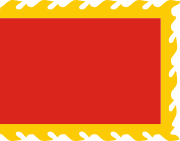
Flag of the Tây Sơn dynasty, 1778–1788
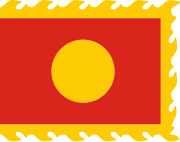
Flag of the Tây Sơn dynasty, 1788–1802

Flag of the Nguyễn dynasty, 1802–1885

Flag of the Nguyễn dynasty, 1920–1945
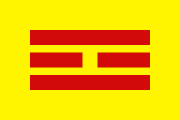
Flag of the Empire of Vietnam, 1945

Flag of Annam and Tonkin in French Indochina, 1923–1945

Flag of Democratic Republic of Vietnam, 1945–1955

Flag of the Autonomous Republic of Cochinchina, 1946–1949
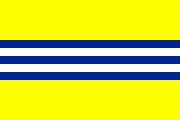
Flag of the Autonomous Republic of Cochinchina, 1946–1949

Flag of State of Vietnam and Flag of Republic of Vietnam, 1949–1975

Flag of Democratic Republic of Vietnam, 1955–1976
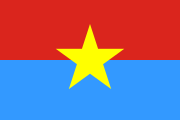
Flag of Provisional Revolutionary Government of South Vietnam, 1969–1976

Flag of Socialist Republic of Vietnam, 1976–present
Notes[]
- ^ In Vietnamese, "golden star" and "yellow star" are all called sao vàng
See also[]
| Wikiquote has quotations related to: Flag of Vietnam |
- List of Vietnamese flags
- Heritage and Freedom Flag
- List of flags of the Republic of Vietnam Military Forces
References[]
- ^ "History of the Vietnam flag". Retrieved 10 October 2020.
- ^ Jump up to: a b "Archived copy". Archived from the original on 7 October 2013. Retrieved 5 October 2013.CS1 maint: archived copy as title (link)
- ^ Jump up to: a b "Decree number 5 of September 05, 1945" Archived 23 April 2013 at the Wayback Machine, Archive of Vietnamese legal documents.
- ^ Jump up to: a b "Resolution number 249/SL of November 30, 1955", Archive of Vietnamese legal documents.
- ^ Jump up to: a b "Resolution of July 07, 1976", Archive of Vietnamese legal documents.
- ^ "Flag of Vietnam". Encyclopedia Britannica. Retrieved 4 March 2021.
- ^ Constitution of the Socialist Republic of Vietnam, Article 141.
- ^ Jump up to: a b c "VN Embassy : Flag Designer Urban Myths Squelched", Embassy of the Socialist Republic in Vietnam in the United States of America.
- ^ Sơn Tùng's writing was published in installments in the newspaper Sài Gòn Giải Phóng and later as a book entitled Nguyễn Hữu Tiến (1981).
- ^ "Flag designer urban myths squelched". vietnamnews.vn. Retrieved 4 March 2021.
- ^ "Tác giả quốc kỳ: vẫn là dấu chấm hỏi", Tuổi Trẻ, 23 November 2006
- ^ Ho Chi Minh, Foreign Languages Pub. House, 1988, p. 76. "on 19 May 1941 Viet Minh Front officially made its appearance, and holding high the gold star red flag."
- ^ Cima, Ronald J., ed. (1990). "The General Uprising and Independence". Vietnam : A Country Study. Dept. of the Army. ISBN 978-0160181436.
The following day, the Congress, at a ceremony in front of the village dinh, officially adopted the national red flag with a gold star, and Ho read an appeal to the Vietnamese people to rise in revolution.
- ^ Phút Tán Nguyẽn, A Modern History of Viet-nam (1802–1954), 1964. p. 502. "The Assembly then adopted national Anthem and national flag, approved a new Cabinet and a Committee in charge of the drafting of the Vietnamese Constitution."
- ^ "Vietnam". CIA World Factbook. Central Intelligence Agency. Retrieved 29 May 2013.
- ^ Van Tan, "The Insurrection of the Two Trung Sisters"
- ^ Jump up to: a b c d Khải Chính Phạm Kim Thư, "The National Flag of Free Vietnam Archived 4 February 2009 at the Wayback Machine"
- ^ Nguyễn Đình Sài, "Quốc Kỳ Việt Nam: Nguồn Gốc và Lẽ Chính Thống", Vietnam Reform Party. A translation is given here.
- ^ Nguyễn, Ngọc Huy. (March & April 1988) "National Flags and National Anthems of Vietnam" Tự Do Dân Bản magazine, issue: 27 & 28. Re-published in July 2015. Archived from original (in Vietnamese). p. 3 of 15
- ^ Compare to
 (South Korean Flag).
(South Korean Flag).
- ^ Jump up to: a b c Vietnam, World Statesman.
External links[]
| Wikimedia Commons has media related to National flag of Vietnam. |
- National symbols of Vietnam
- Flags of Vietnam
- National flags













